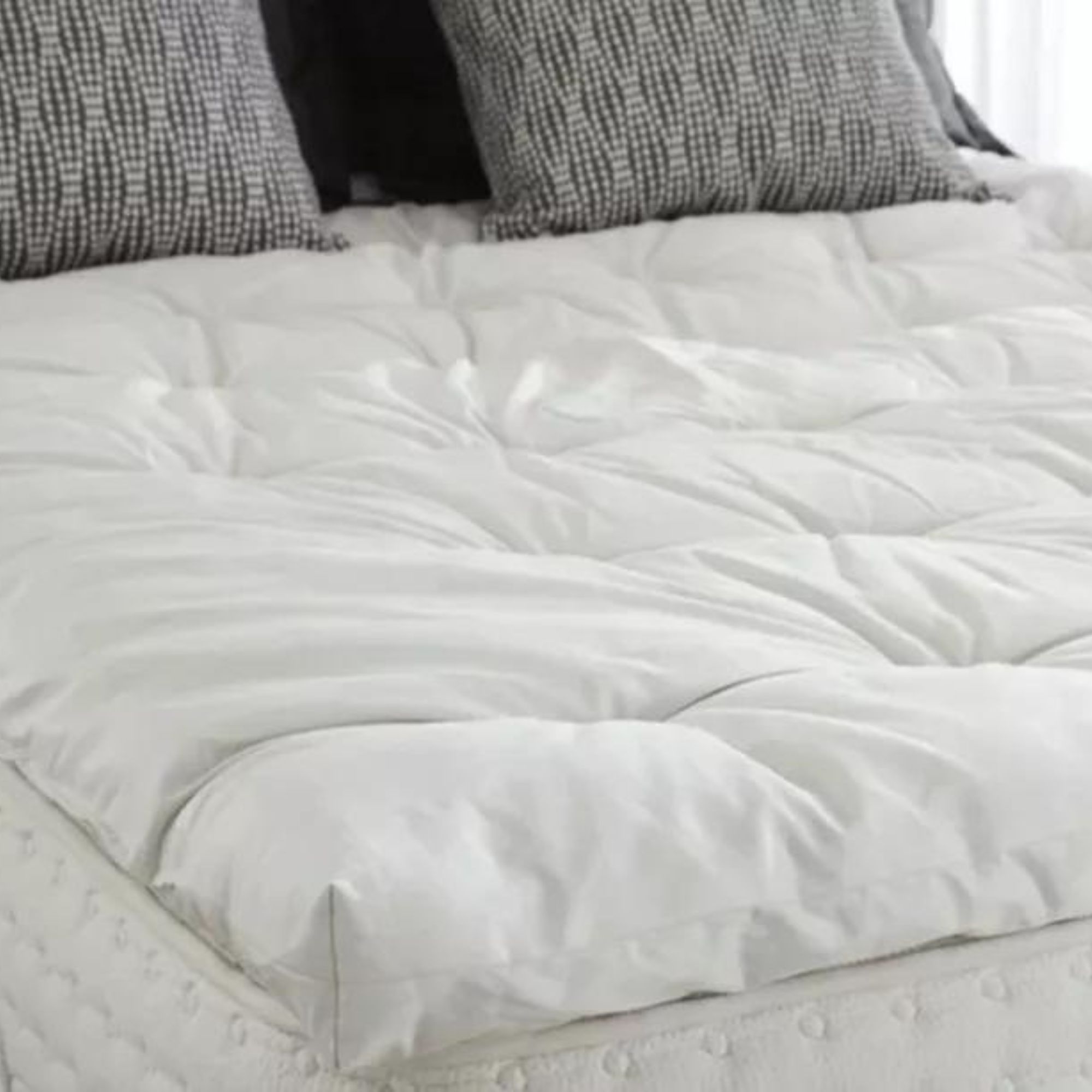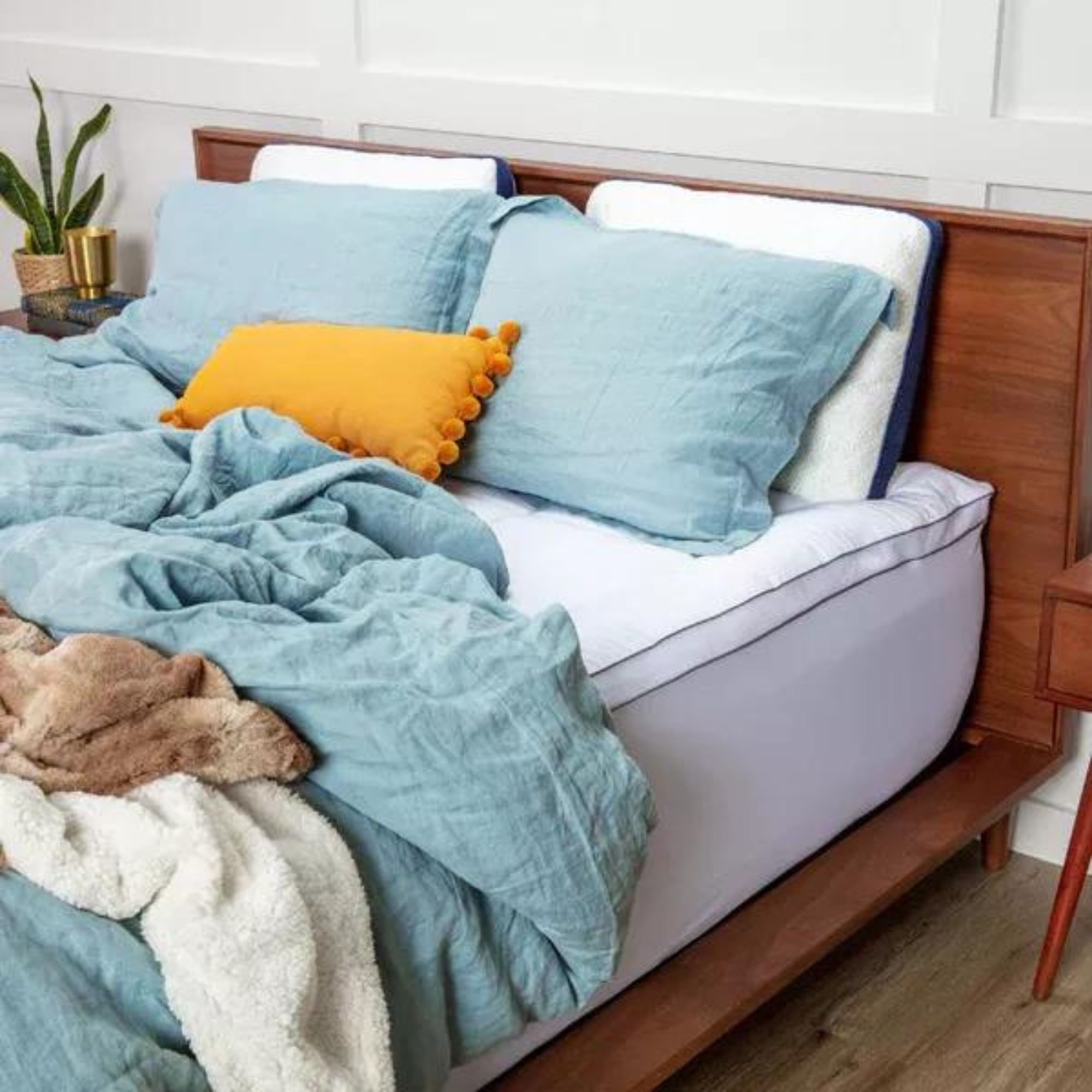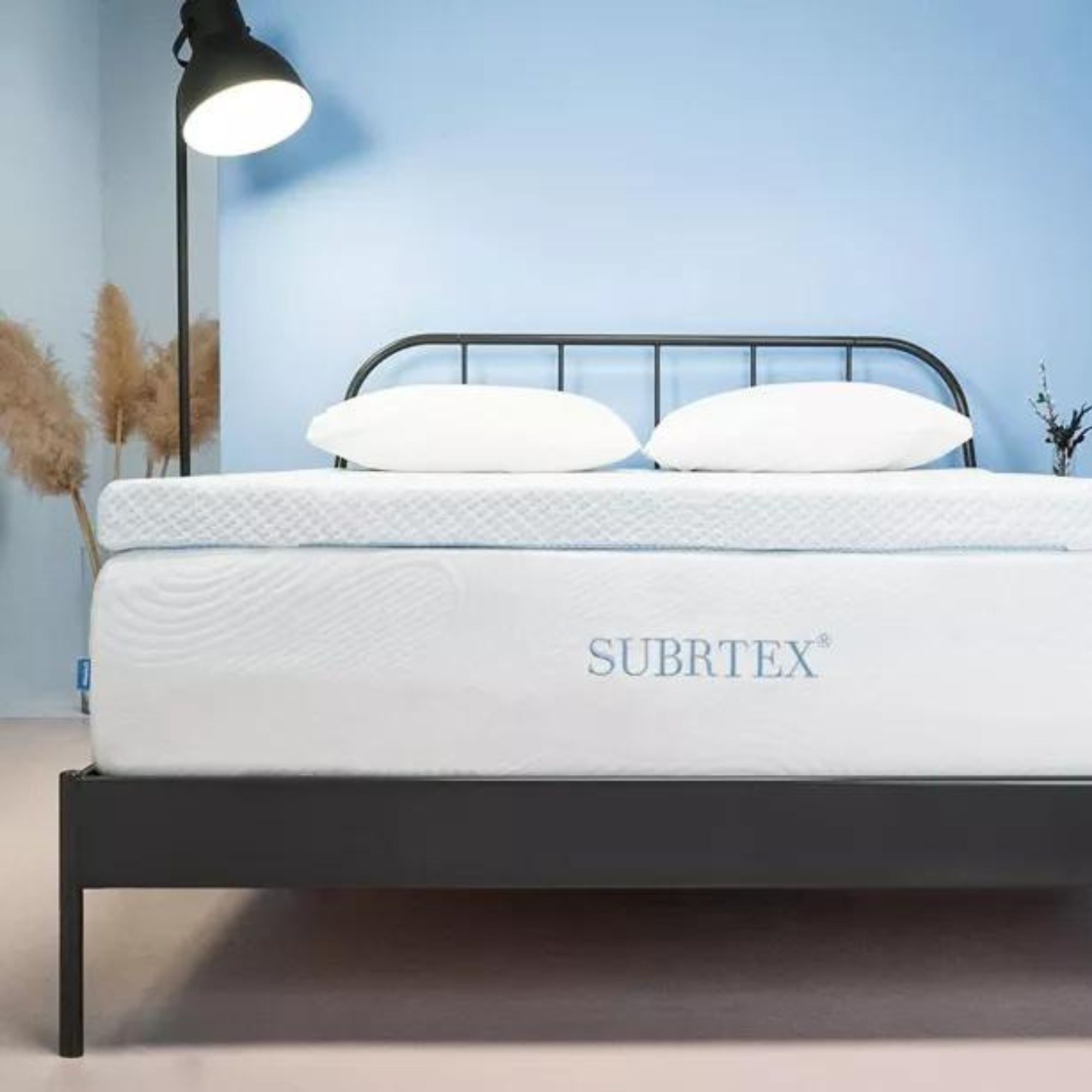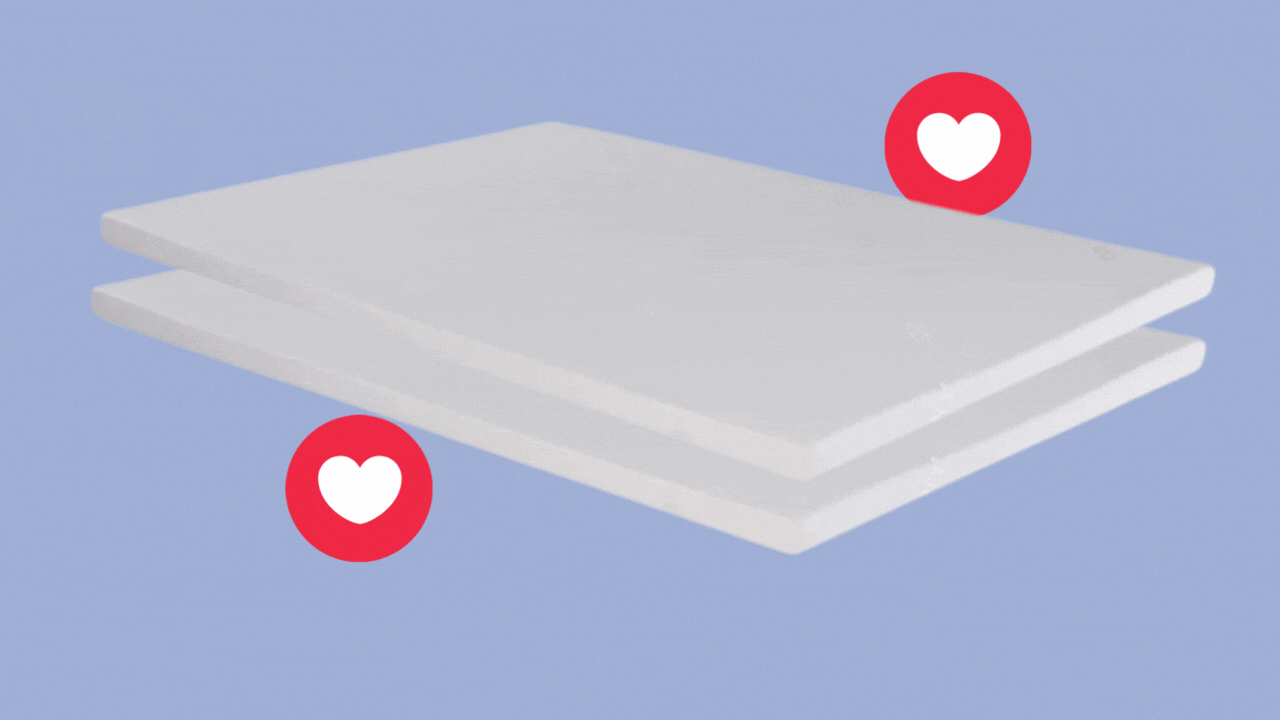

Honestly: a mattress topper can totally transform your sleep. No, it won't take away your work stress or get your roommate to turn their music down, but it will up the comfort levels on your current bed. You might be laying on an old mattress your mom got you way back when, or perhaps yours was provided to you by your landlord and you just can't get along with it. Either way, it's not the mattress of your dreams. But it could be.
Obvs, it is important to do your research before buying a mattress topper, because even though these bby's might be a fraction of the price of a new mattress, choosing the wrong one could be costly. There are lots of mattress topper types, materials, and thicknesses to think about — get the most amazing option for you, and you can recreate the comfort of a brand new bed, for less.
To take your bed from lumpy to lush ASAP, I've spoken to industry experts and put together a simple six-step guide with some of my top mattress toppers to help narrow down your search.
1. What's on the inside matters
There are lots of types of mattress toppers to choose from, and the one you choose will come down to personal preference — memory foam can be a bit of a love/hate material.
Not everyone is so set on what cushioning they'd like to sleep on. And deciding is not as simple as giving it a squish with your hand or bouncing on a bed and judging whether you like it. The material of your topper matters when it comes to allergies, support, and most of all, whether you're wanting a topper to pretty much replace your mattress, or simply add a pillowy top to one you find too firm (and visa versa).
If you get the sniffles at night, you'll want to stay away from natural fillings and opt for a memory foam mattress topper instead. But if you're wanting a super-soft topper to transform your hard sleep surface, a feather or down-alternative option will get you cloud-like sleep. Something in between? A hybrid obvs.
See the most common mattress topper types below:
- Memory foam mattress toppers are the most popular choice. It molds to your body's shape and gives plenty of support, making it perfect for side sleepers or anyone with back pain. They're usually the thickest and therefore more likely to transform your current bed to the point where you forget what it felt like before.
- Down-alternative / microfibre toppers will simply up your comfort levels to cloud-like. If you want the feeling of sleeping on a load of tiny pillows, a polyester-filled topper will feel soft to the touch, without the occasional stab of a feather poking through.
- Feather and down are luxurious topper fillings, making them both the most expensive and plush to the touch. If you can afford one and aren't worried about any allergies, then it makes sense to invest in this mega mattress upgrade.
- Hybrid mattress toppers are constructed with one memory foam layer, and one feather or down-alternative layer, so you'll get softness and support for the best of both worlds. If you don't have any particular needs when it comes to sleep, you can't go wrong with a hybrid.
- Latex toppers are putting non-toxic materials on the map. Ideal for eco-lovers and allergy sufferers alike, it's better for the environment and for you. Growing in popularity, latex is found to be a very durable material that can be expected to support you soundly for years. They tend to be on the firmer side.
- Organic mattress toppers cover a range of natural material types, like cotton, wool, hemp, and flax, all of which do not include polyurethane foam. Organic mattress brands should have an alternative to the chemical fire retardants that are used in other mattresses and may feature vegan options as Avocado or Saatva do.
The best mattresses toppers by type
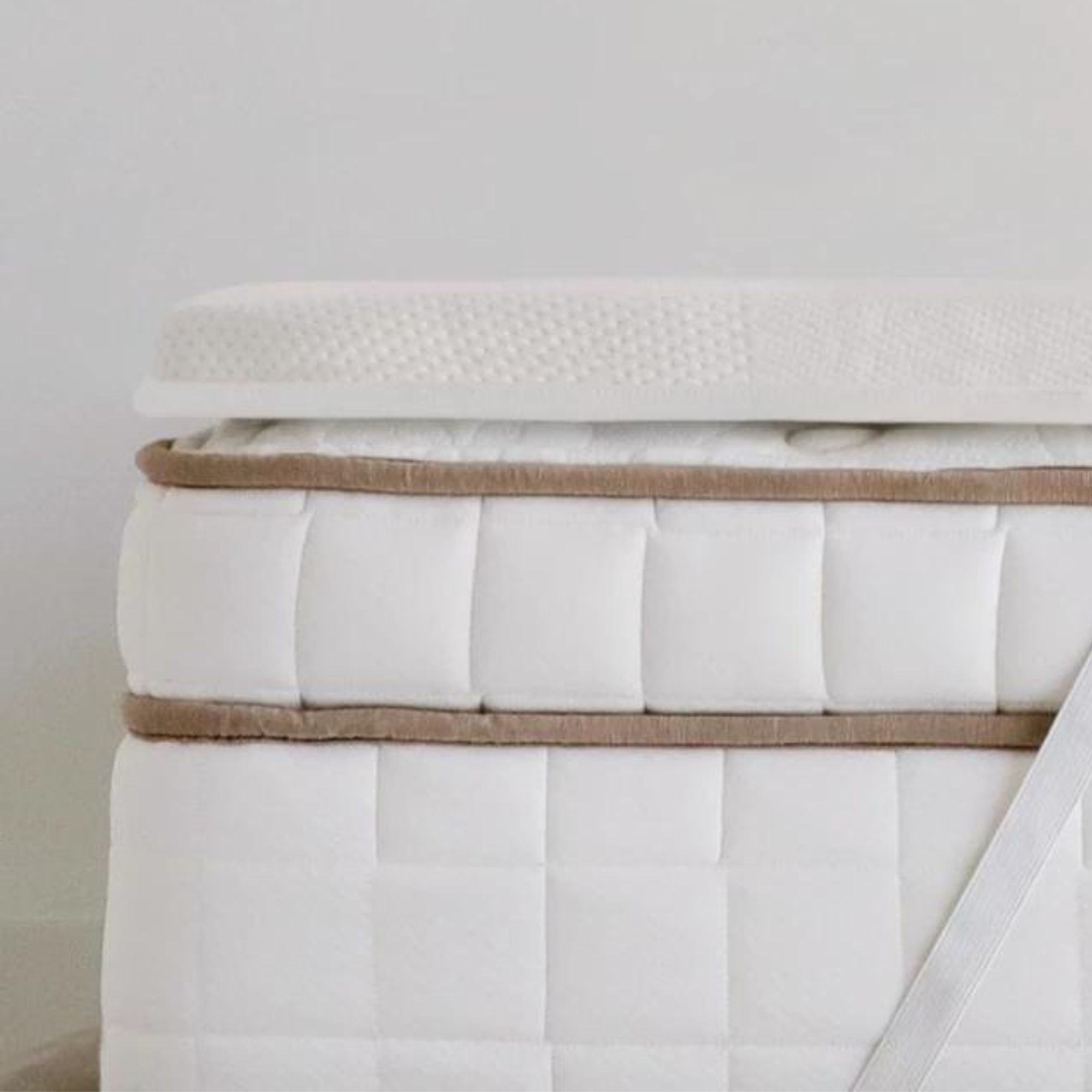
The best memory foam mattress topper
Read our Saatva foam mattress topper review.
2. Figure out your sleep style
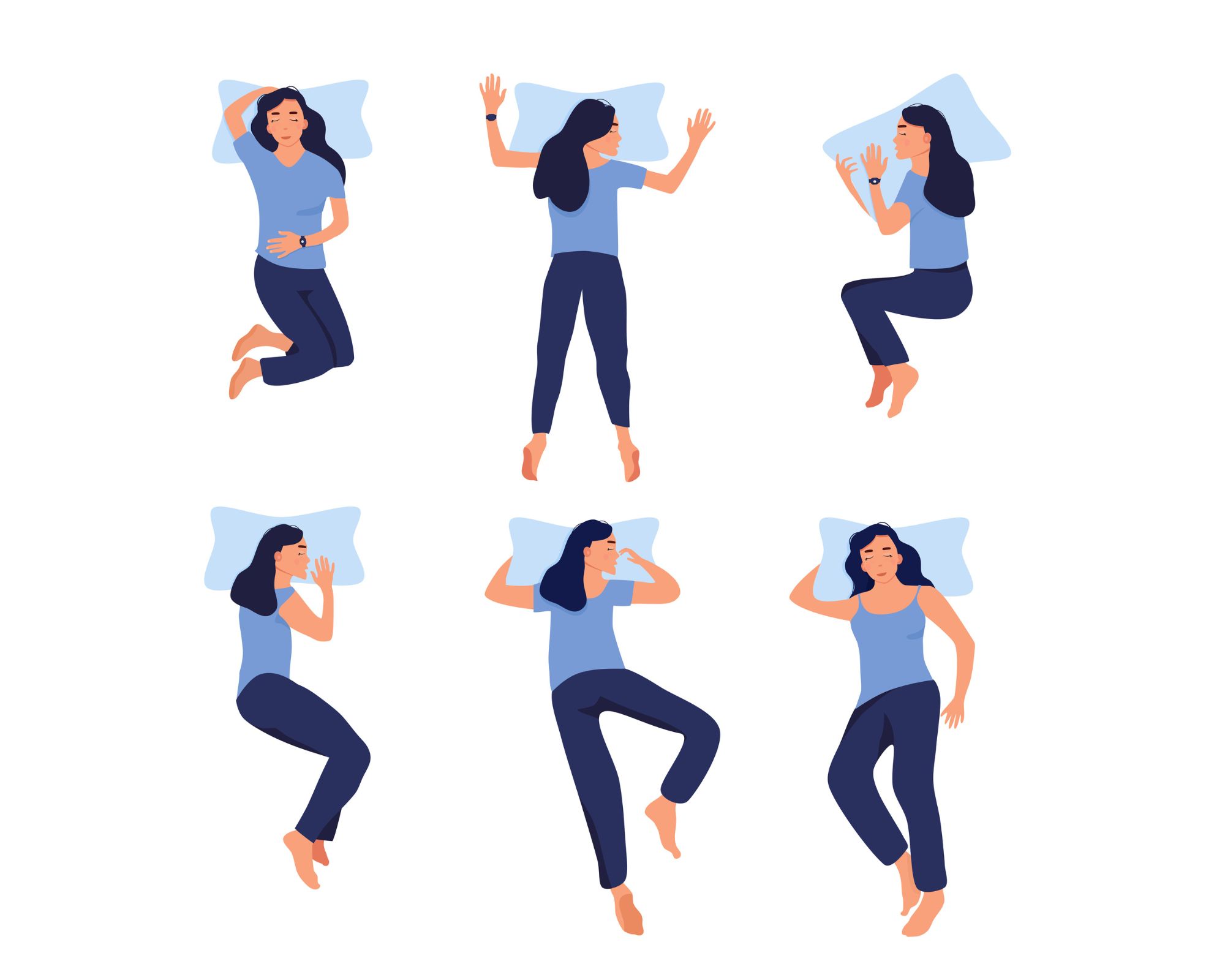
Choosing a mattress topper according to how you rest is the easiest way to increase comfort levels.
PS: The pillow you sleep on will also impact your sleep position. It might be worth looking into how to choose a pillow for the ultimate sleep set-up. For now, see which firmness rating you should choose based on your sleeping position:
- Side sleepers are prone to experiencing achy joints, especially around the hips and shoulders due to poor spinal alignment. See whether your knee overlaps the other or sits on top. Opting for a softer mattress topper you can sink into is the way to go, with medium-soft being the most recommended comfort grade.
- Stomach sleepers might experience sore pressure points in the ribcage, knees, and elbows, as well as "general spinal discomfort." In order to alleviate this, you will need to find a firm sleep surface that supports you but also cushions in those sensitive areas.
- Back sleepers are recommended a middle-ground mattress for maximum comfort: not too soft, not too firm. In the words of Goldilocks, make sure your bed is "just right" in order to hold you tight in all the right places.
Thickness
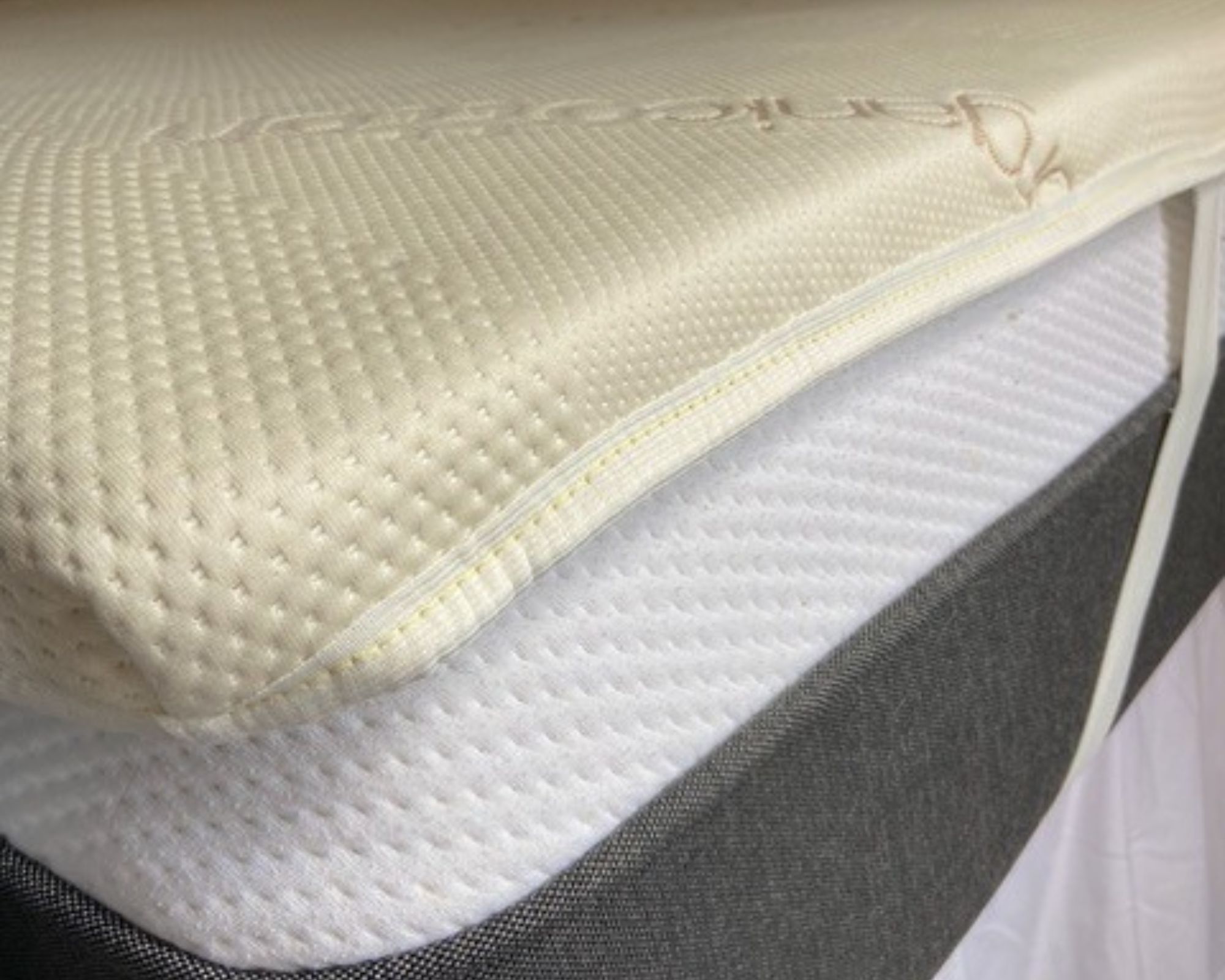
Mattress toppers can range in thickness, some adding a thin layer of cushioning, others adding a good few inches to totally transform your bed — yep, just like a Princess and the pea moment. How thick you want your mattress topper to be, will depend on whether you're wanting your topper to substitute a brand new bed (in which case, the thicker the better), or a softer sleep surface than the one you've already got. The average topper is around three inches, with the thinnest being 1.5 and a super-thick one considered at the five-inch mark. If you are wanting a topper with depth, remember that your bed will be significantly taller, and you'll need to buy a deep fitted/flat sheet, if you haven't got one already.
4. Any additional sleep needs?
Just the same as it is when choosing a new mattress, getting a mattress topper is far from a one-size fits all approach. As you'll know from experience, it can be hard to get comfy when sleeping alongside a partner or friend. One of you might get back pain, the other might overheat, or even have allergies — we all have different sleep needs.
Topper types and different mattress brands may feature special add-ons that cater to more specific needs. We've got your back covered with help from Po-Chang Hsu, MD, who is a medical content expert at SleepingOcean.com. Together we've broken down five common issues and how choosing the right sleep surface can solve them:
- Experiencing back pain? "When dealing with chronic or frequent pain, it’s best to choose a mattress topper that can offer decent pressure relief," explains Hsu. "Such mattresses typically use adaptive memory foam. The material molds to the sleeper’s body, encouraging tension to spread out evenly and, thus, alleviating pain."
- Allergy sufferer? Consider latex as a filling (if you're not allergic to latex, of course) and designs marketed as hypoallergenic. This refers to a mattress that is made with materials less likely to trigger your sneezes and itches. Memory foam/hybrids will be good for you, too.
- Do you overheat at night? Find a mattress topper made of breathable materials. A big warning here is that memory foam is prone to giving off heat. As Dr. Po-Chang Hsu suggests, "It’s best to choose models that use cooling materials, such as natural latex, breathable cottons, or gel-infused foam, etc."
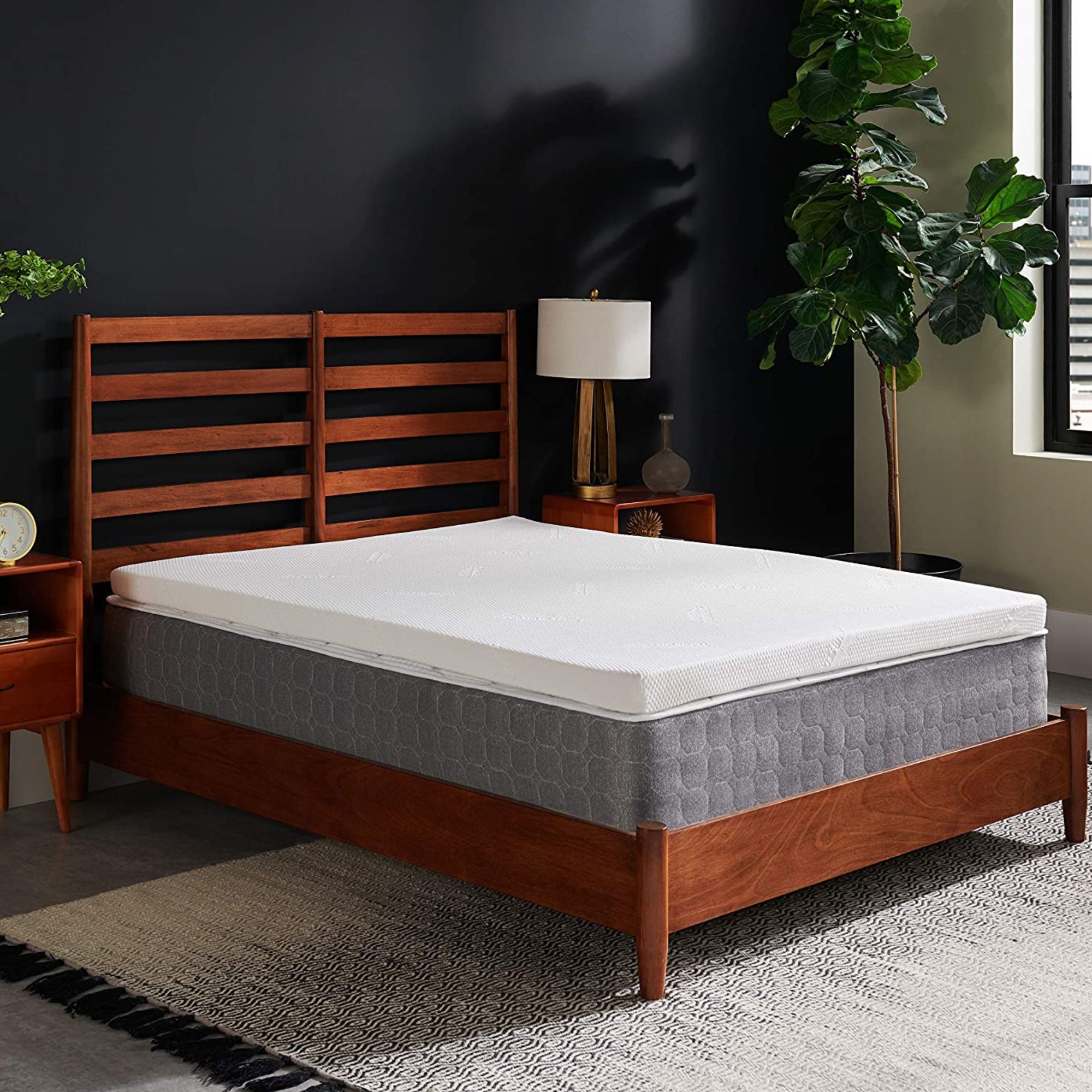
The best mattress topper for support
Read our Tempur-Pedic Tempur Supreme mattress topper review.
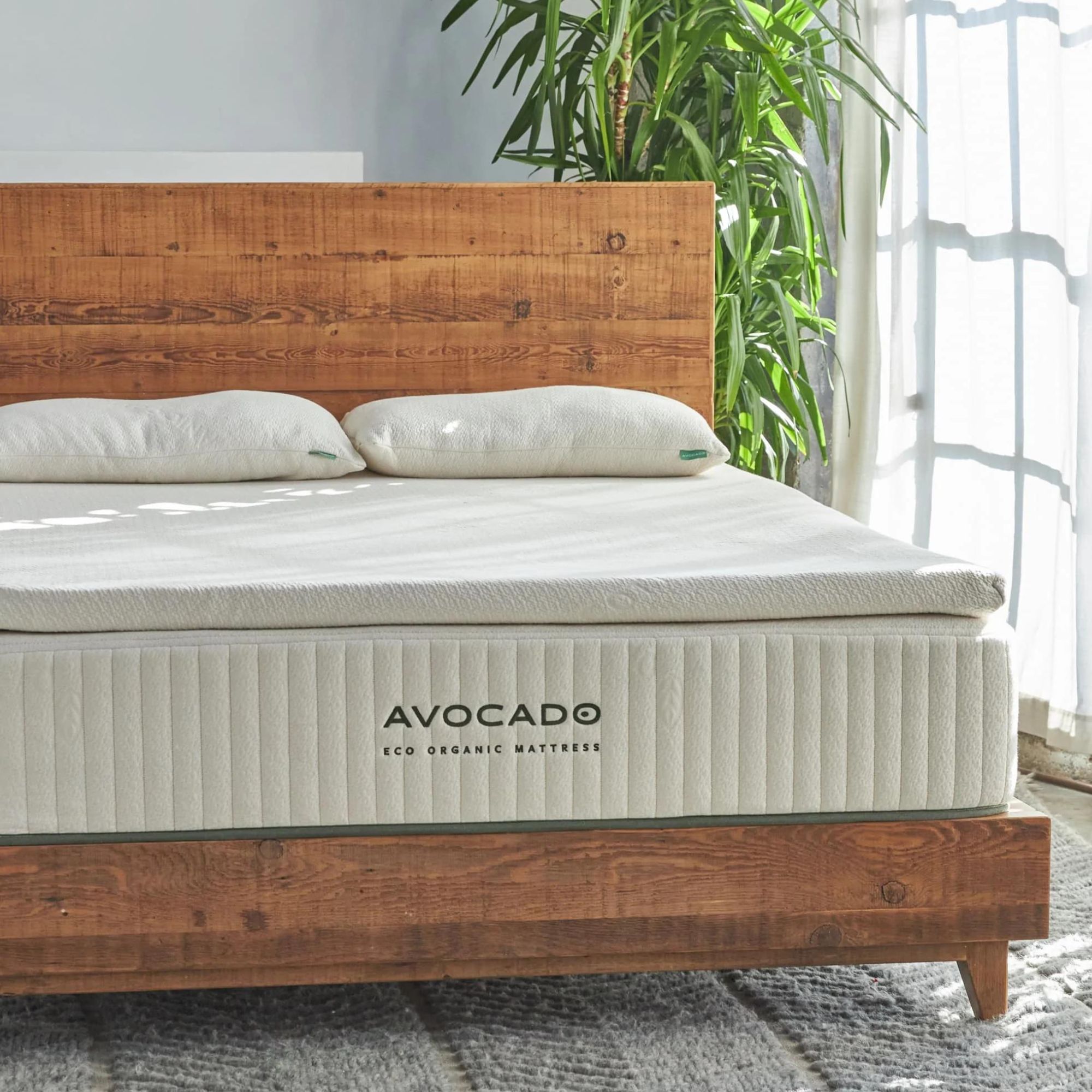
The best organic mattress topper
Psst! This product is currently in review.
5.Size
Okay, it may sound simple, but make sure your topper is the right size. By the "right" size, I'm referring to the size of your mattress. Most mattress brands in the US offer topper sizes the same as your mattress, from twin all the way to California king. There are other sizes in-between standard variations that, if ordered incorrectly, may mean your topper will overhang or not be able to be attached properly. You really won't want it to slip around as you sleep.
6. How much are you willing to spend?
The great thing about mattress toppers is that they are SO much cheaper than investing in a brand-new mattress. Yup, they're still a little costly (the cheapest you could get a *good* topper for is around $100, but there are even more affordable options out there. And honestly: the price to upgrade your sleep massively, without having to totally splurge on a new bed, is impressive.
A great mattress topper will help your current mattress last longer — whether it's new, or not, and perform as a great substitute until you've saved enough to cash in on the bed of your dreams. If you rent, are in a college dorm or are planning on moving soon, then they're also a lot more convenient than having to heft a heavy mattress Ross from Friends style up a stairwell.
If you've got your eye on a slightly spendy branded mattress topper, perhaps to go with your current mattress, or to add to the uncomfy one you've had for years, it's worth looking at bedding and mattress sales on RN to get one with a discount.
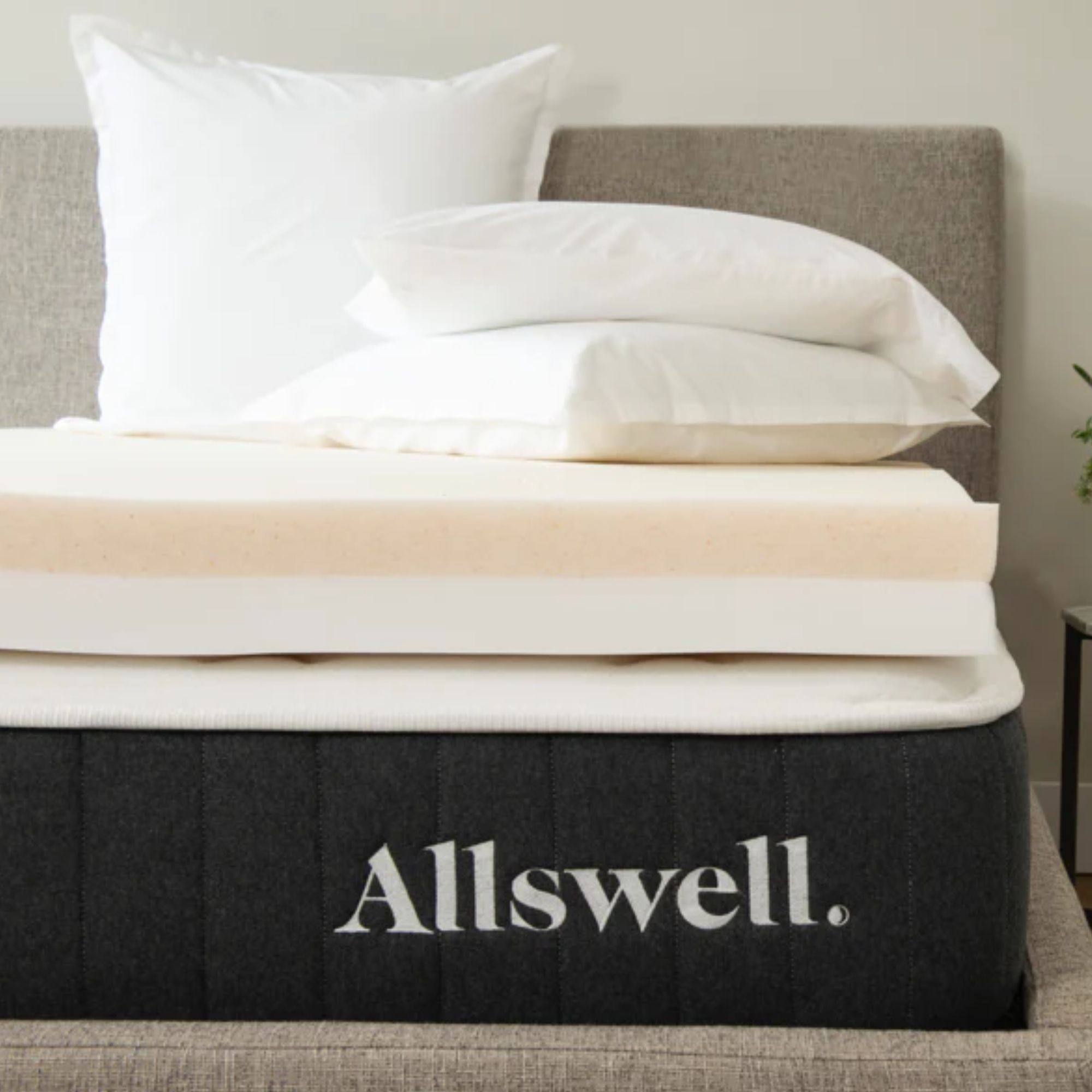
The best cheap mattress topper
Read our Allswell mattress topper review.
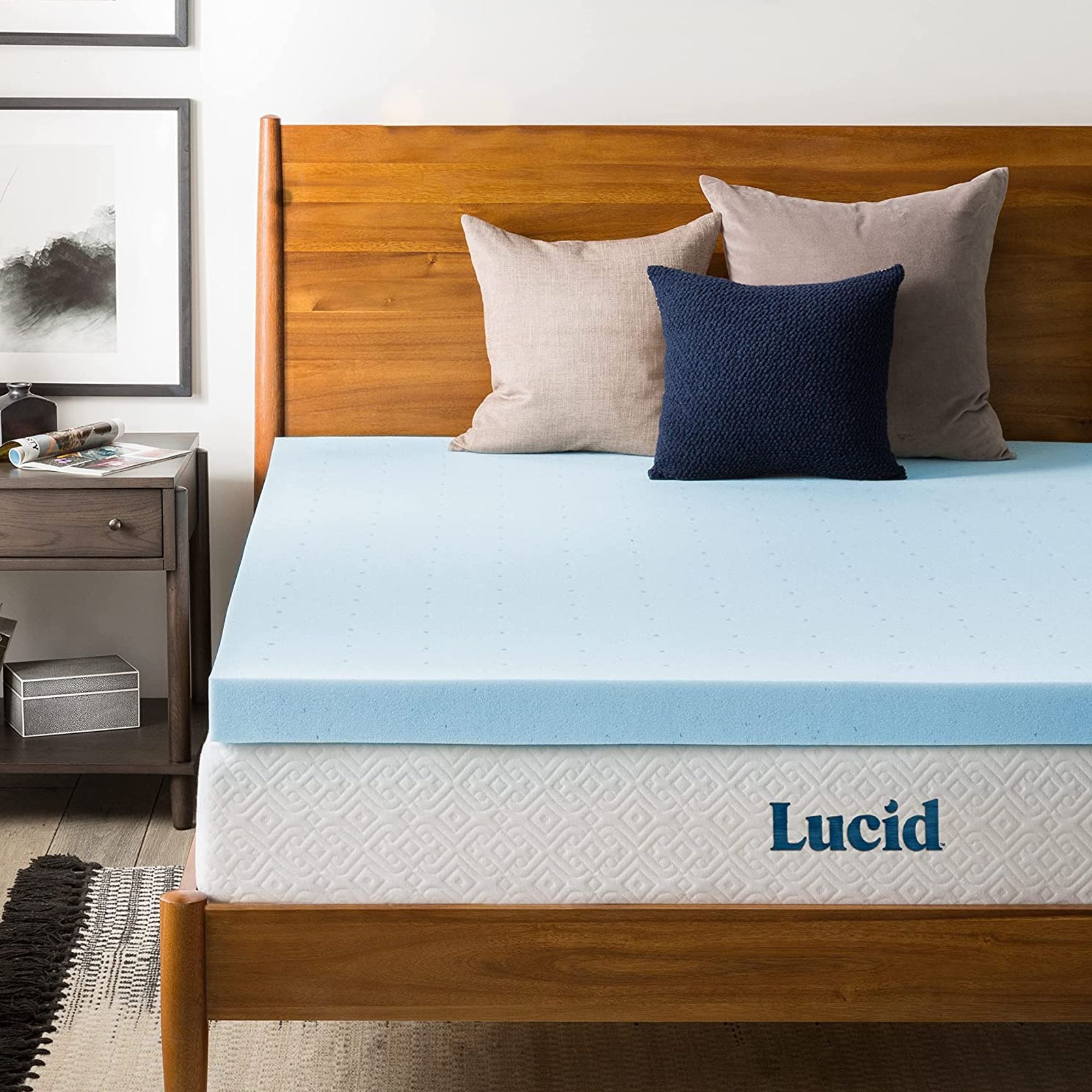
The best mattress topper on Amazon
Psst! This product is currently in review
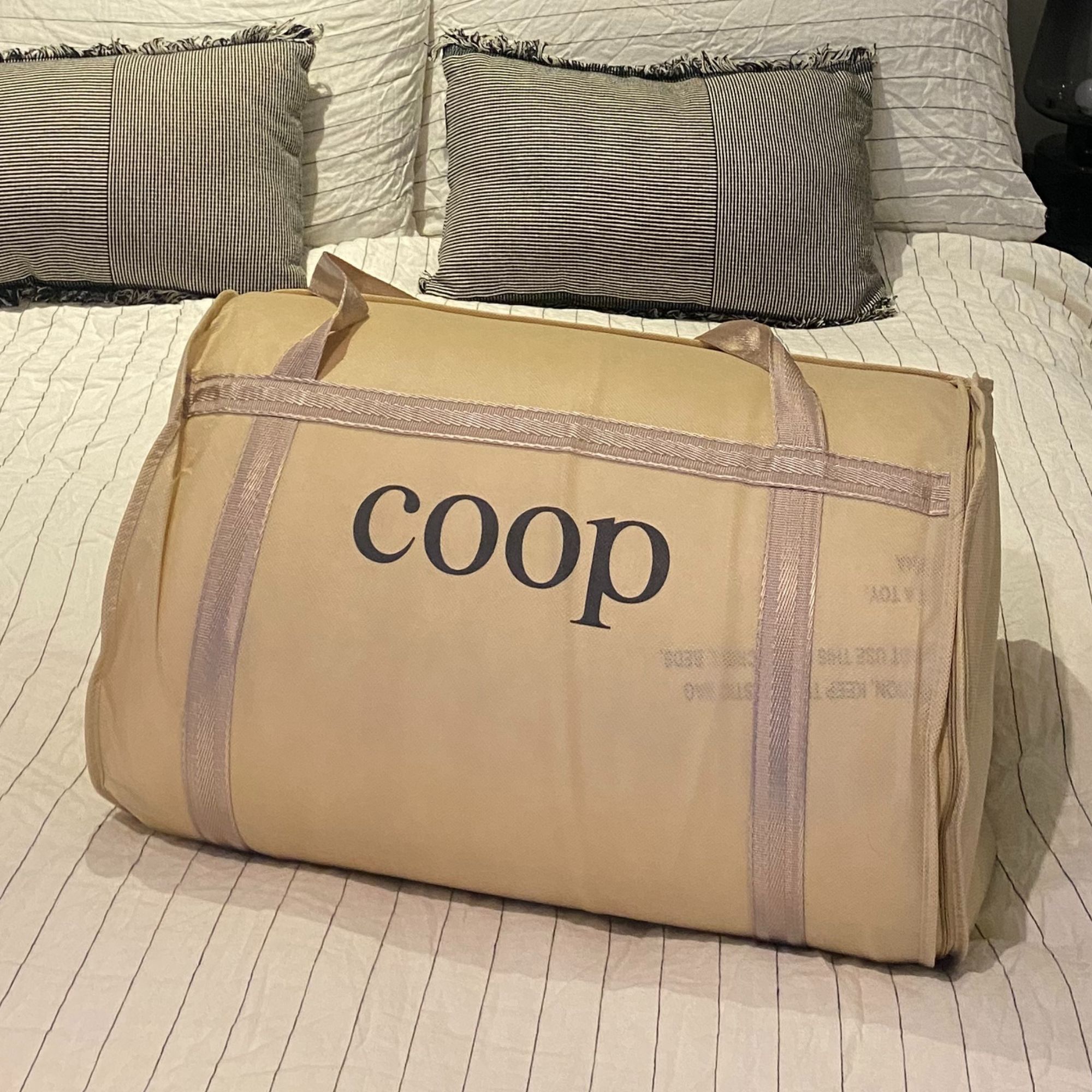
The best mattress topper worth the splurge
Read our Coop retreat mattress topper review.
Join our newsletter
Get small space home decor ideas, celeb inspiration, DIY tips and more, straight to your inbox!

Louise is the Ecommerce Editor at Real Homes, specialising in sleep content so you can wind-down well. With prior PR experience working for a luxury bedding brand, Louise knows the importance of getting a great night’s sleep. Joining the other side of the desk as a full-time journo, Louise brings her bedding expertise to writing sleep buying guides, reviews, and news for Real Homes. Aside from helping readers get essential shut eye, Louise also writes shopping content for homeware items that’ll add a decorative edge to your space. With an eye for design that won’t snooze on style, but a budget that won’t quite stretch, Louise loves nothing more than a modern designer dupe. From coloured glassware to contemporary storage, anything to upgrade the bare space of her rented East London flat.
-
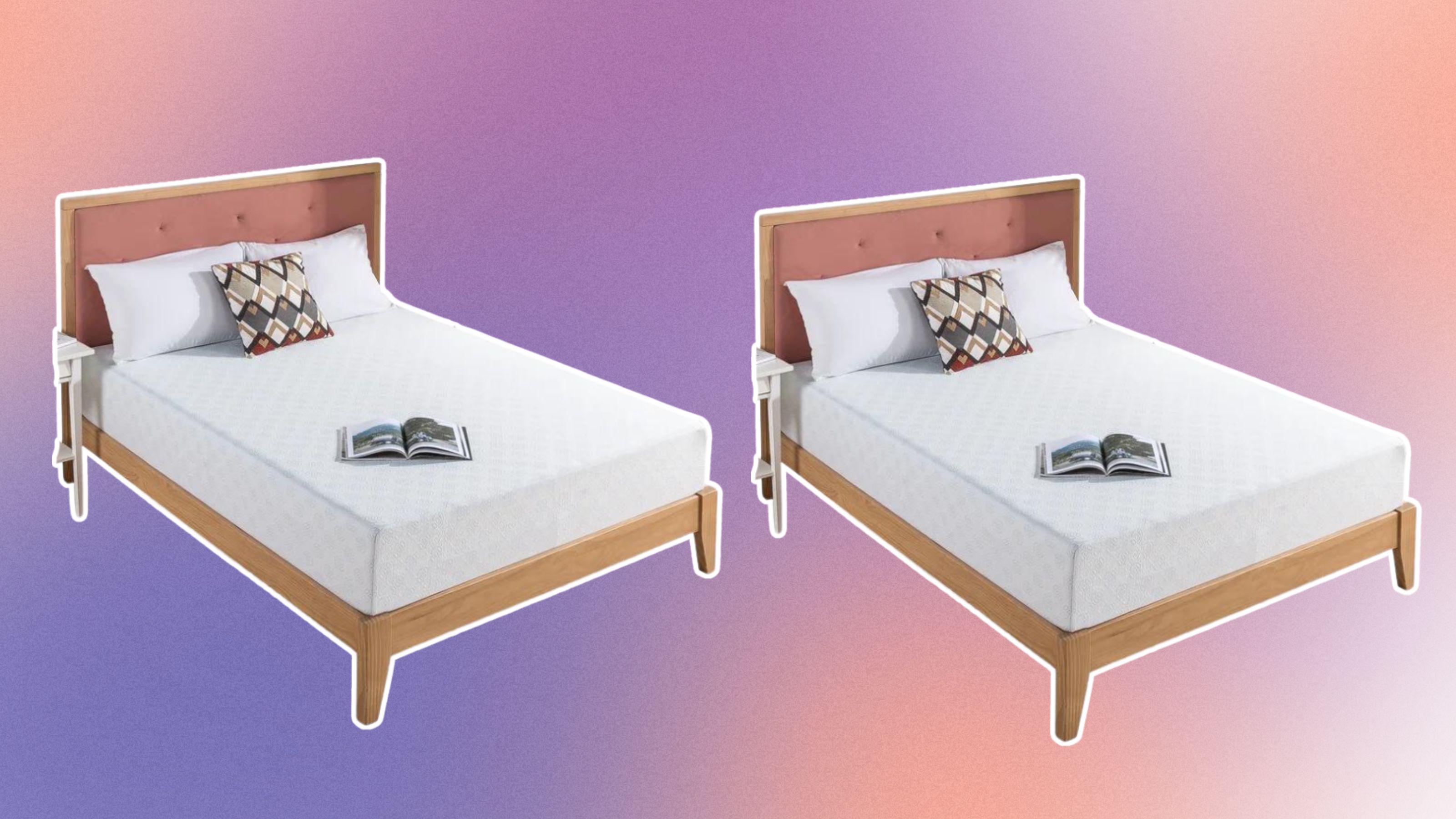 Shoppers approve of this Wayfair cooling mattress on sale now for less than $270
Shoppers approve of this Wayfair cooling mattress on sale now for less than $270See the Wayfair cooling mattress with over 18k reviews and 4.6 stars for summer sleeping. Plus, more cooling sleep essentials on sale now
By Emily Lambe Published
-
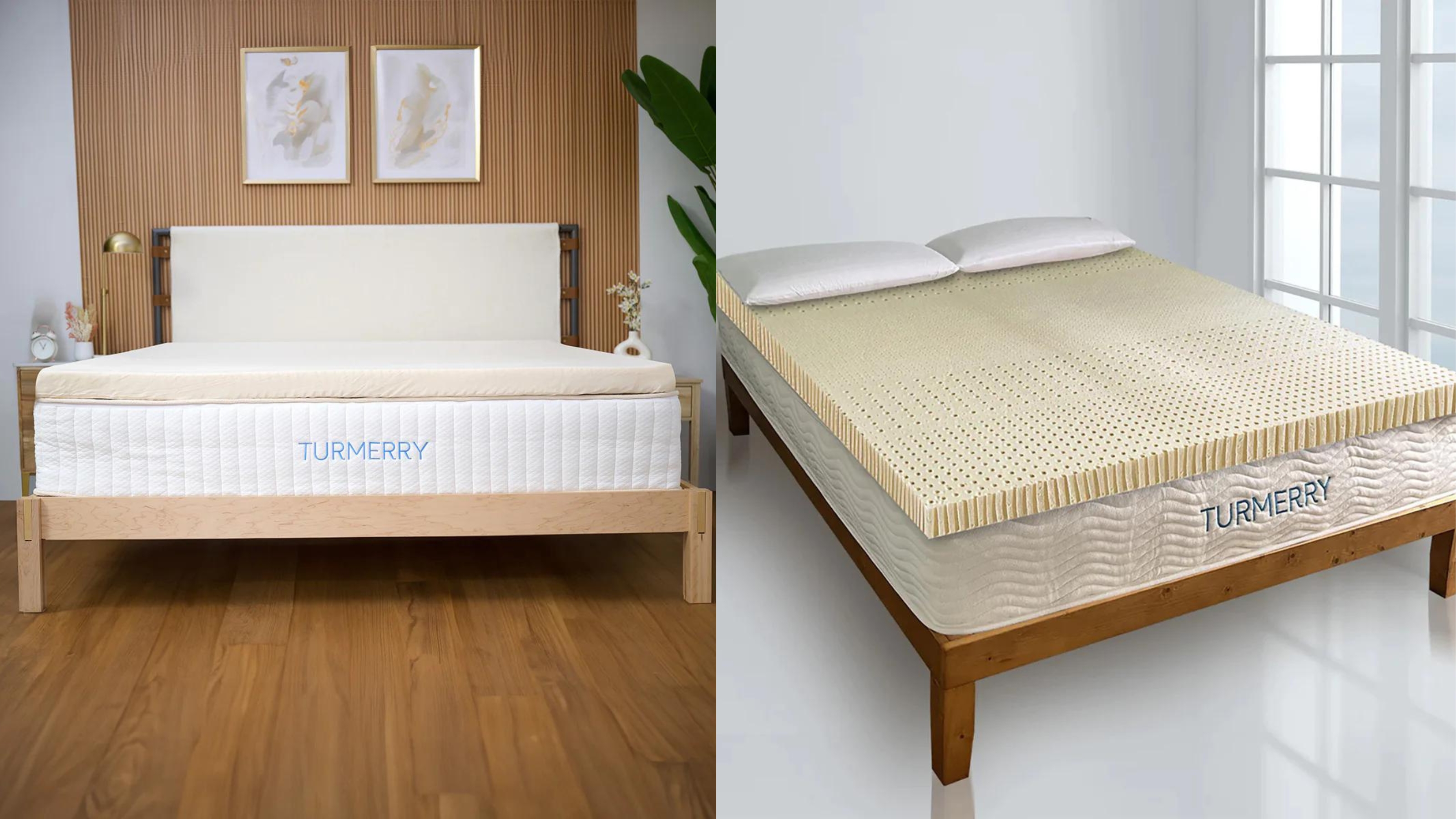
 Turmerry Latex Mattress Topper review: a perforated pick for the perfect night's sleep
Turmerry Latex Mattress Topper review: a perforated pick for the perfect night's sleepContributing editor, Paige Cerulli tests the Turmerry Latex Mattress Topper in her midwestern home
By Paige Cerulli Published
-
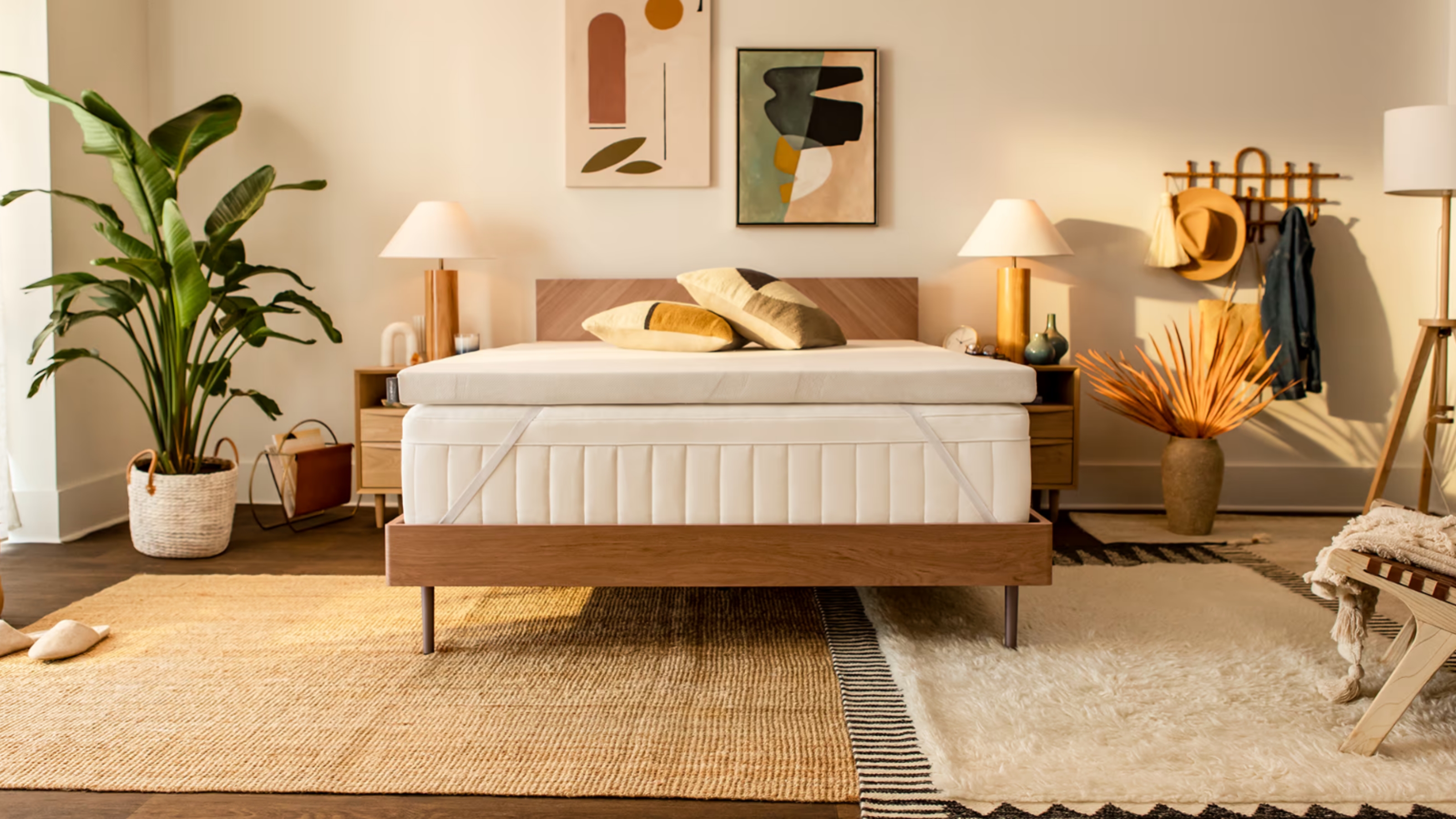 6 best cooling mattress toppers and pads to buy — from $89.99
6 best cooling mattress toppers and pads to buy — from $89.99Half a dozen of the best cooling mattress toppers and pads to buy if you are a hot sleeper, or live in a warm climate. Including Surbtex and Tempur Pedic options
By Christina Chrysostomou Last updated
-
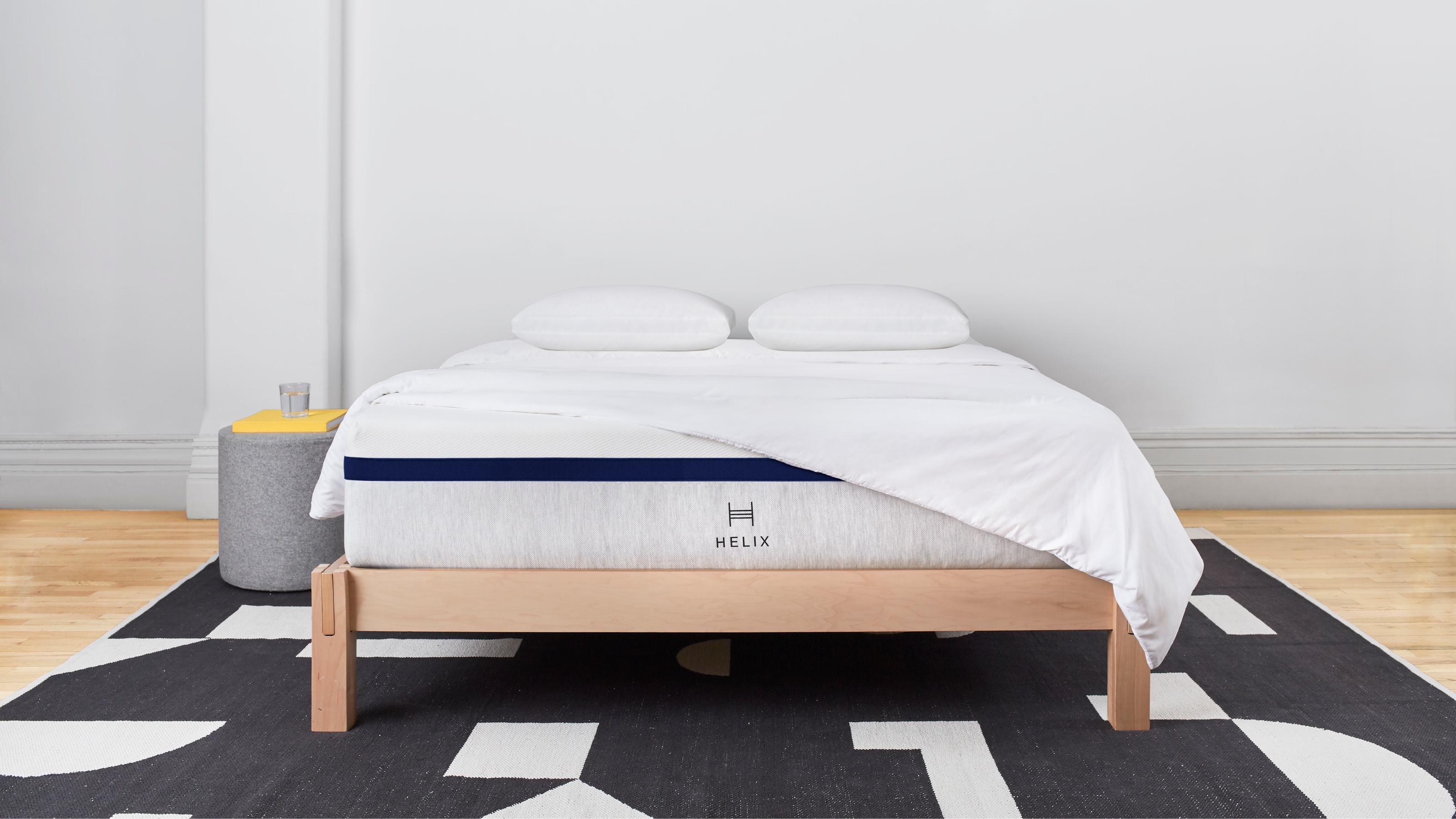 Helix Midnight Mattress: As a front sleeper, I declare it the comfiest base I've ever slept on
Helix Midnight Mattress: As a front sleeper, I declare it the comfiest base I've ever slept onSee our Helix Midnight mattress review to see if this hybrid design is right for you. We tested it out for over one month to find all the pros and cons.
By Emily Lambe Published
-

 Zinus ultra cool gel mattress topper review
Zinus ultra cool gel mattress topper reviewOur freelance contributor Camryn Rabideau shares her thoughts on the Zinus Ultra Cool Gel Memory Foam Mattress Topper after four weeks of sleeping on this temperature-reducing bedding accessory.
By Camryn Rabideau Published
-
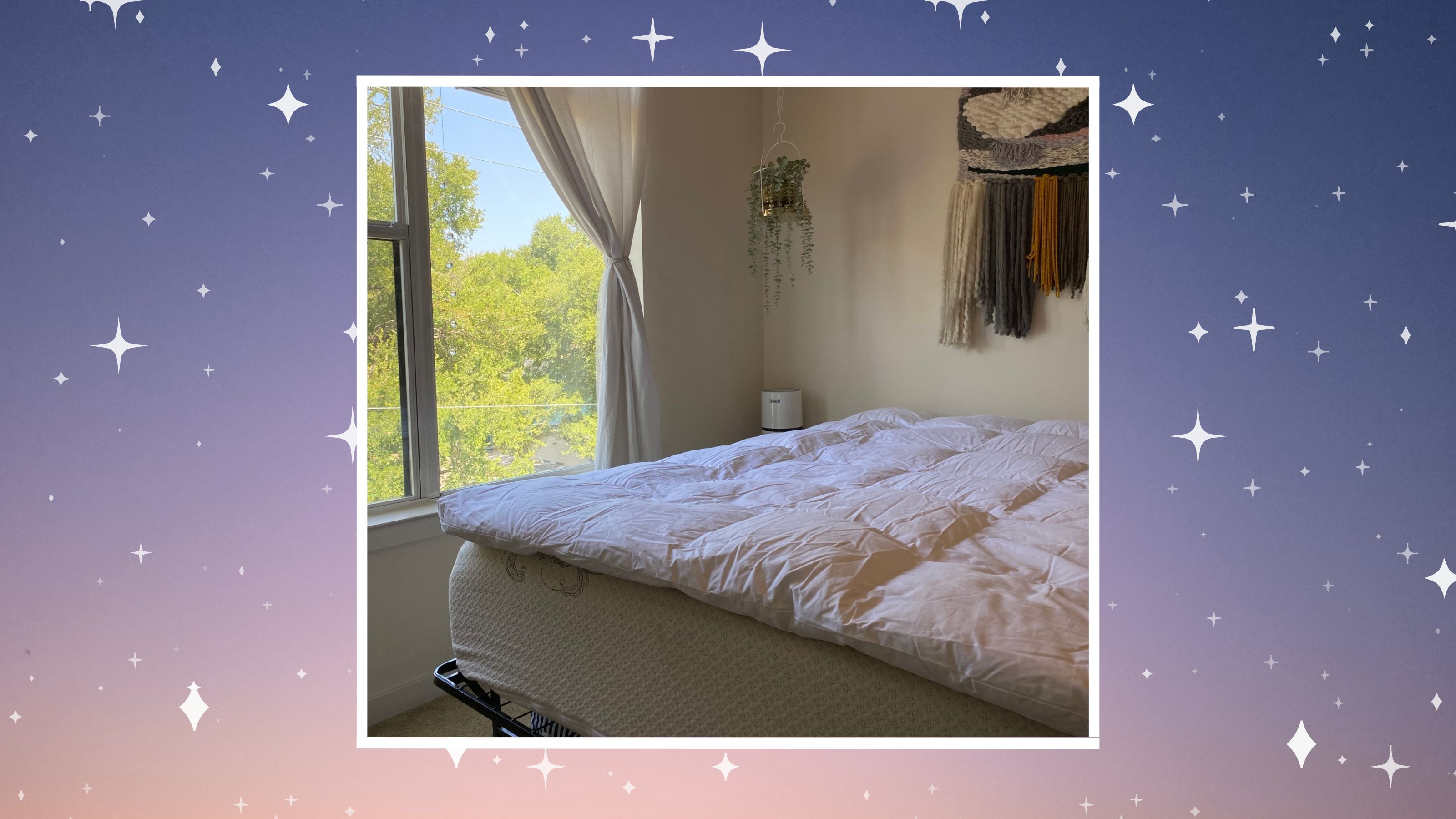
 This Parachute mattress topper is the cure for an uncomfortable mattress — especially if you're a back sleeper
This Parachute mattress topper is the cure for an uncomfortable mattress — especially if you're a back sleeperThis Parachute Mattress Topper transformed my years-old mattress from sad to super soft. It's so comfortable for back sleepers like me.
By Rose Cain Published
-
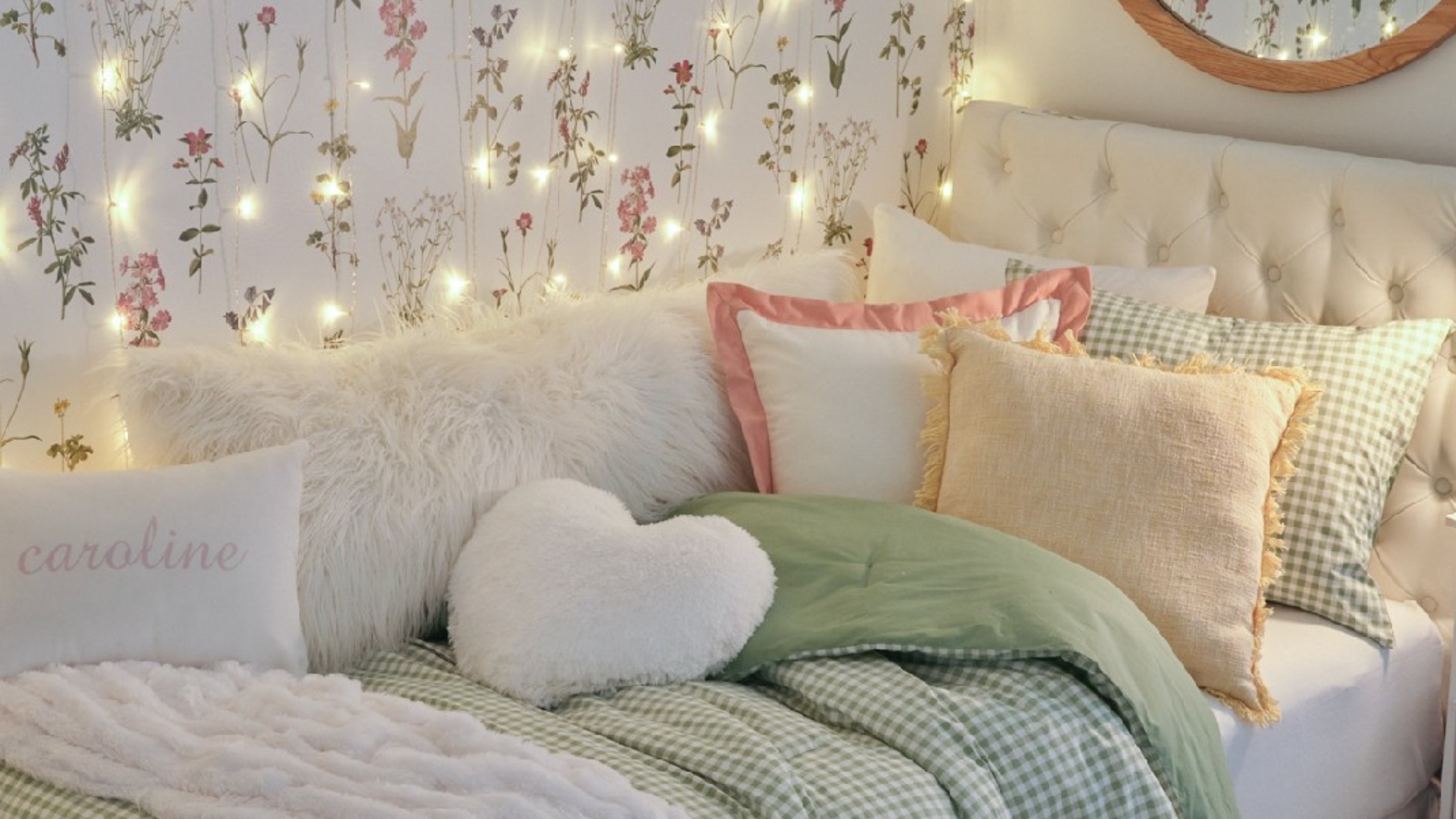 6 ways to stay warm in your dorm room when it's freezing outside
6 ways to stay warm in your dorm room when it's freezing outsideFeeling the chill this semester? See our top ways to stay warm in your dorm room without pissing off your roommate or RA including bedding ideas.
By Kara Thompson Published
-
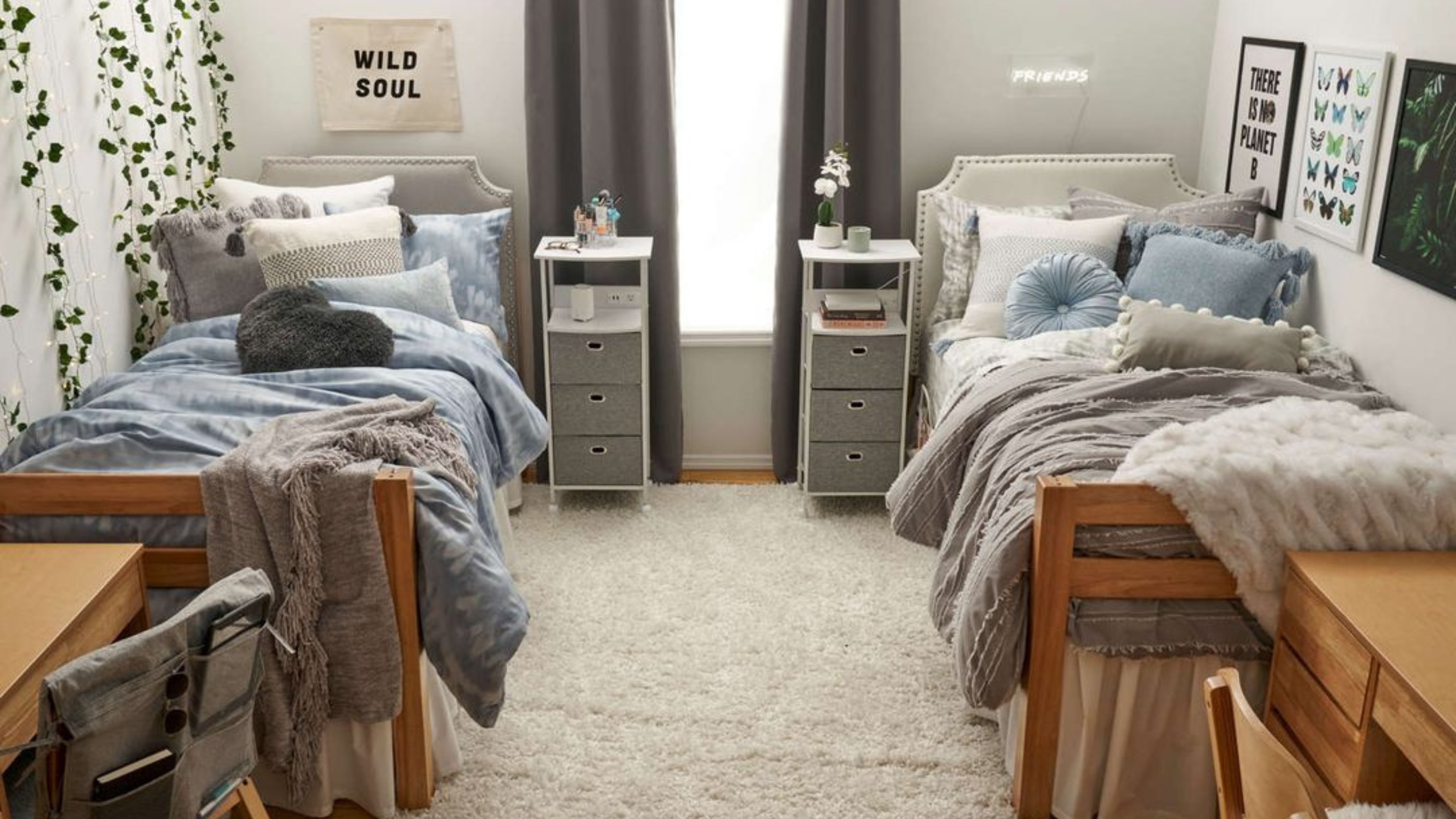 10 tips for *actually* getting some shut eye in a dorm, straight from sleep experts
10 tips for *actually* getting some shut eye in a dorm, straight from sleep expertsYes, we're talking about a *real* all-nighter!
By Danielle Valente Published
